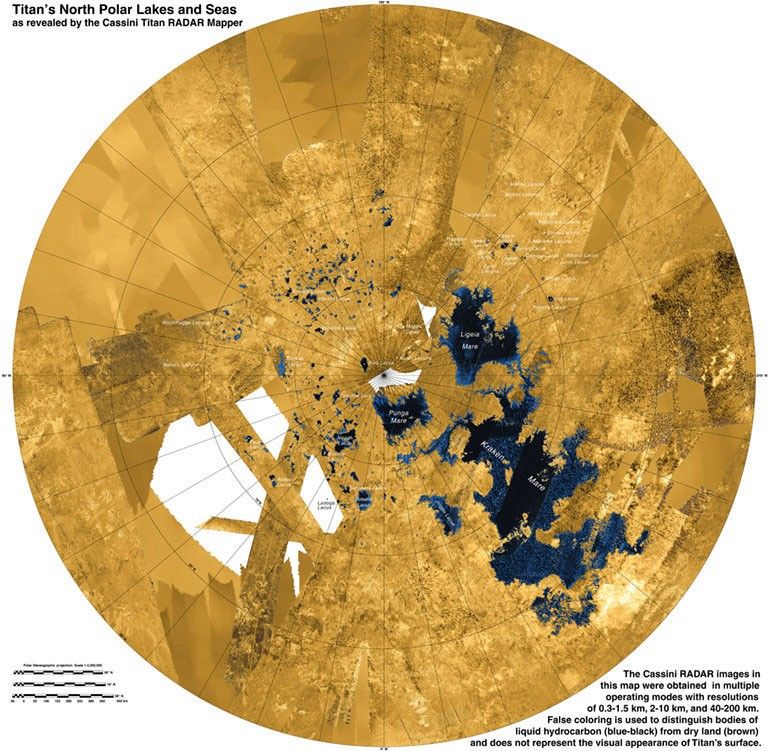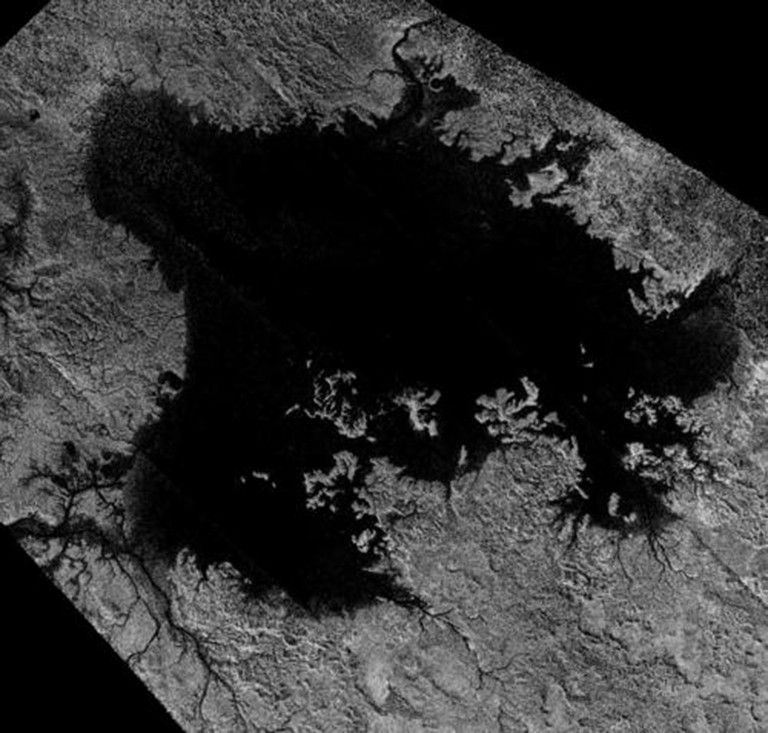On July 1, 2004 UTC, the Cassini-Huygens spacecraft fired its main engine to reduce its speed, allowing the spacecraft to be captured by Saturn's gravity and enter orbit.
Cassini completed its initial four-year mission to explore the Saturn System in June 2008 and an extended Cassini Equinox Mission through 2010. Now, the healthy spacecraft is working even more overtime on the Cassini Solstice Mission, seeking answers to new questions raised in Cassini’s first years at Saturn.
In addition to the close Titan fly-bys highlighted below, 2014 offers Cassini some other scientific highlights:
- high inclination orbits around Saturn that will provide excellent views of Saturn's poles and rings
- passage through new regions of Saturn's magnetosphere with measurements of unique magnetotail crossings
- a coordinated Saturn auroral campaign with joint Earth-based observations
- numerous unique ring occultations with large ring opening angles to probe the densest rings
Jan. 1
Titan flyby (870 miles, or 1,400 kilometers) – T-97: The visible and infrared mapping spectrometer (VIMS) is prime during closest approach. As the spacecraft moves from the North Pole to the South Pole, it will map the equatorial region east of Adiri at a resolution of one kilometer per pixel.
Feb. 2
Titan flyby (768 miles or 1,235 kilometers) – T-98: Radar will perform synthetic aperture radar (SAR), a technique which uses that spacecraft's flight path to simulate a very large radar aperture, of Ontario Lacus (providing change detection from T-57/58 and T-65).
March 6
Titan flyby (933 miles, or 1,500 kilometers) – T-99: The radio science subsystem instrument (RSS) team starts their Titan Gravity science observation. During the Solstice Mission, the main science objectives of gravity measurements at Titan are: 1) assess the presence of a global subsurface ocean by measuring the short-period changes of the gravity field induced by Saturn’s tidal field (eccentricity tides); 2) determine the geoid of the satellite and the presence of large scale gravity anomalies; and 3) determine the rheology of the icy crust by correlative analysis with altimetric data.
April 7
Titan flyby (598 miles, or 963 kilometers) – T-100: The ion and neutral mass spectrometer (INMS) is the prime instrument at closest approach. T-100 is local noon (Cassini relative to Titan) in the mid Southern latitudes. It is also in the noon local time for Titan relative to Saturn and in the outer flank of the magnetosphere. Combined with a period of (expected) high solar activity, this is a key observation for the magnetospheric interaction region and understanding solar input effects on Titan’s ion and neutral atmospheres. VIMS will conduct global and regional mapping of Titan at medium resolution and will observe an ingress occultation of the star Antares by Titan. The composite infrared spectrometer (CIRS) carries out a vertical mapping near 43 degrees south in the far-infrared: the most southerly latitude reached with far-IR limb sounding during the inclined central part of the Solstice Mission.
May 17
Titan flyby (1,860 miles, or 2,994 kilometers) – T-101: RSS outbound bistatic observation crosses Ligea Mare and the northern tip of Kraken Mare. This is an RSS 10 point flyby– one of the two most scientifically valuable flybys for RSS during the Solstice Mission. A successful bistatic will yield important information about the surface status (liquid/solid), surface reflectivity, surface dielectric constant and implied composition, and surface roughness. Earlier, a ultraviolet imaging spectrograph (UVIS) stellar occultation probes Titan’s atmosphere to provide a high-resolution vertical profile of hydrocarbons, haze and temperature.
June 18
Titan flyby (2,273 miles, or 3,659 kilometers) – T-102: RSS carries out a Titan Occultation in order to 1) determine seasonal changes in the high latitude atmosphere, specifically the temperature structure and formation and breakup of the winter polar vortex; 2) determine tropospheric winds from radio occultation measurements of tropospheric temperature profiles; 3) determine the atmospheric and ionospheric structure at all levels. This flyby also presents the second of two northern lake-crossing bistatic opportunities implemented in association with RSS Titan occultations. The geometry of such opportunities is usually less optimal than that of standalone bistatic opportunities such as those on T-106 and T-124, hence tend to have less chance of surface echo detectability. They have proved useful nonetheless. The T-102 bistatic ground grazes presently known edge of Ligeia Mare (2009), covering roughly the 70 degrees north to 75 degrees north latitude region between 240 degrees west and 310 degrees west longitude. It terminates within the northern region of Kraken Mare. It captures scattering angles decreasing from about 80 to 60 degrees, partly within the Brewster angle range. The inbound bistatic covers the region (20 degrees south, 15 degrees west) to (50 degrees south, 25 degrees west) and covers incidence angle increasing from about 45 to 70 degrees, also partly within the Brewster angle range. Measurements of the absolute strength of the echo and its polarization properties, when detectable, yield critical information about the surface status (liquid/solid), surface reflectivity, surface dielectric constant and implied composition, and surface roughness.
July 20
Titan flyby (3,171 miles, or 5,103 kilometers) -- T-103: This is a UVIS ten point flyby, making this one of the two most scientifically important Titan flybys for the UVIS team during the Solstice Mission. There is a stellar occultation of Achernar (Alp Eri): ingress latitude between -33.1 and 38.6 degrees, egress latitude between -0.1 and 11.2 degrees. There is an UVIS solar occultation as well: ingress lat/long:-65.5/22.1 degrees, egress lat/long: 57.7/227.2 degrees. This is an exceptional UVIS science opportunity because 1) the stellar occultation is very slow, providing much better signal/noise and vertical resolution than most occultations; 2) we also have a solar occultation; and 3) we are also doing a limb observation at the same latitude as the solar occultation. The limb observation and solar occultation give complementary information on conditions (temperature, density) in Titan's thermosphere/ignorosphere. This combination will allow us to cross-check the results from each experiment. The limb observation is to measure emissions from nitrogen molecules and atoms.
Aug. 21
Titan flyby (599 miles, or 964 kilometers) -- T-104: INMS is prime during closest approach. T-104 is near local noon for Cassini relative to Titan at mid Northern latitudes. It occurs at midnight local time for Titan relative to Saturn and is on the inner flank of the magnetospheric interaction region. T-104 compliments T-100 in close temporal proximity and will allow direct comparisons of the noon and midnight regions for Titan relative to Saturn. INMS is prime inbound, riding with Radar outbound, so the ionospheric measurements will be degraded outbound, but still an excellent pass for INMS. Radar is inbound ride-along, outbound prime SAR imaging of southern (as yet unimaged by radar) part of Kraken Mare. Inbound scatterometry/radiometry, HiSAR and altimetry.
Sept. 22
(Sept. 21 at 9:23 p.m. PDT), Titan flyby (870 miles, or 1,400 kilometers) – T-105: UVIS performs a stellar occultation of Eta Ursa Majoris. Ingress latitude is between -28.9 and -34.2 degrees; egress latitude is between -25.0 and -30.7 degrees. Inbound, CIRS resumes far-infrared vertical sounding, focusing on 40 degrees north latitude, to retrieve aerosols and haze opacities. VIMS will then acquire medium resolution images (12 to 3 miles [20 to 5 kilometers] per pixel) for a mosaic of Tsegihi and the dune fields of Fensal. A high-resolution image of Sinlap crater may be possible before recording a high resolution South-North swath between minus 5 minutes and plus 5 minutes across the mid-northern latitudes. On the outbound, VIMS will observe the seas and lakes of the northern polar area, including Kraken and Ligeia at resolution better than 3 miles (5 kilometers) per pixel. It will look for the evolution of evaporitic material. Finally, while riding along with CIRS, it will look for specular reflection on Kraken Mare and look for wave activity on this large sea.
Oct. 24
(Oct 23 at 6:41 p.m. PDT), Titan flyby (629 miles, or 1,013 kilometers) – T-106: T-106 is one of only two Solstice Mission opportunities of outbound geometry optimally suited for capturing potential mirror-like surface echoes from the northern lakes region starting from about closest-approach (to enhance chances of surface echoes detectability). It primarily covers the eastern region of Kraken Mare, roughly from about 50 degrees north, 320 degrees west to about 70 degrees north, 295 degrees west. It captures scattering angles increasing from about 50 to 60 degrees, well within the Brewster angle range for likely surface compositions. Measurements of the absolute strength of the echo and its polarization properties, when detectable, yield important information about the surface status (liquid/solid), surface reflectivity, surface dielectric constant and implied composition, and surface roughness.
Dec. 10
Titan flyby, (609 miles, or 980 kilometers) – T-107: T-107 is one of two passes in the Solstice Mission where INMS and the navigation team will simultaneously measure Titan’s atmosphere. This is critical to understanding the differences in the atmospheric density calculated by INMS, Nav, articulation control subsystem (AACS) and UVIS. Navigation will determine Titan's atmospheric density by measuring the acceleration of drag on the spacecraft with Doppler shift observations. T-107 is one of the NAV “10 pointer” flybys for the Solstice Mission.
Spacecraft Event Time
Dates are listed in Spacecraft Event Time (SCET), which is the time the something happens at the spacecraft based on Coordinated Universal Time (UTC).







































